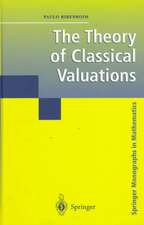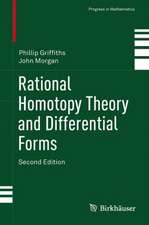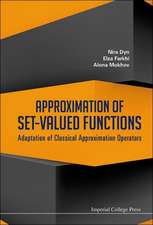Topology: Undergraduate Texts in Mathematics
Autor K. Jänich Traducere de S. Levyen Limba Engleză Hardback – 30 ian 1984
| Toate formatele și edițiile | Preț | Express |
|---|---|---|
| Paperback (1) | 416.34 lei 6-8 săpt. | |
| Springer – 3 oct 2012 | 416.34 lei 6-8 săpt. | |
| Hardback (1) | 423.47 lei 6-8 săpt. | |
| Springer – 30 ian 1984 | 423.47 lei 6-8 săpt. |
Din seria Undergraduate Texts in Mathematics
- 17%
 Preț: 362.13 lei
Preț: 362.13 lei - 17%
 Preț: 365.43 lei
Preț: 365.43 lei - 17%
 Preț: 368.61 lei
Preț: 368.61 lei -
 Preț: 351.54 lei
Preț: 351.54 lei -
 Preț: 424.14 lei
Preț: 424.14 lei - 8%
 Preț: 384.89 lei
Preț: 384.89 lei - 15%
 Preț: 417.75 lei
Preț: 417.75 lei -
 Preț: 400.43 lei
Preț: 400.43 lei -
 Preț: 449.62 lei
Preț: 449.62 lei -
 Preț: 400.43 lei
Preț: 400.43 lei -
 Preț: 372.27 lei
Preț: 372.27 lei -
 Preț: 402.35 lei
Preț: 402.35 lei -
 Preț: 395.09 lei
Preț: 395.09 lei -
 Preț: 440.01 lei
Preț: 440.01 lei -
 Preț: 304.91 lei
Preț: 304.91 lei -
 Preț: 257.71 lei
Preț: 257.71 lei - 20%
 Preț: 466.84 lei
Preț: 466.84 lei -
 Preț: 380.27 lei
Preț: 380.27 lei -
 Preț: 280.65 lei
Preț: 280.65 lei -
 Preț: 298.01 lei
Preț: 298.01 lei -
 Preț: 407.96 lei
Preț: 407.96 lei -
 Preț: 359.49 lei
Preț: 359.49 lei -
 Preț: 415.95 lei
Preț: 415.95 lei -
 Preț: 358.11 lei
Preț: 358.11 lei -
 Preț: 407.63 lei
Preț: 407.63 lei -
 Preț: 370.78 lei
Preț: 370.78 lei - 17%
 Preț: 367.24 lei
Preț: 367.24 lei -
 Preț: 339.37 lei
Preț: 339.37 lei -
 Preț: 364.41 lei
Preț: 364.41 lei -
 Preț: 398.78 lei
Preț: 398.78 lei - 13%
 Preț: 389.61 lei
Preț: 389.61 lei - 17%
 Preț: 373.60 lei
Preț: 373.60 lei -
 Preț: 433.85 lei
Preț: 433.85 lei -
 Preț: 306.96 lei
Preț: 306.96 lei -
 Preț: 367.41 lei
Preț: 367.41 lei - 17%
 Preț: 362.67 lei
Preț: 362.67 lei -
 Preț: 290.80 lei
Preț: 290.80 lei - 19%
 Preț: 400.52 lei
Preț: 400.52 lei - 17%
 Preț: 366.38 lei
Preț: 366.38 lei - 17%
 Preț: 395.93 lei
Preț: 395.93 lei - 17%
 Preț: 366.40 lei
Preț: 366.40 lei -
 Preț: 329.95 lei
Preț: 329.95 lei - 19%
 Preț: 492.83 lei
Preț: 492.83 lei -
 Preț: 396.24 lei
Preț: 396.24 lei
Preț: 423.47 lei
Nou
Puncte Express: 635
Preț estimativ în valută:
81.03€ • 88.29$ • 68.28£
81.03€ • 88.29$ • 68.28£
Carte tipărită la comandă
Livrare economică 24 aprilie-08 mai
Preluare comenzi: 021 569.72.76
Specificații
ISBN-13: 9780387908922
ISBN-10: 0387908927
Pagini: 193
Ilustrații: IX, 193 p.
Dimensiuni: 155 x 235 x 13 mm
Greutate: 0.47 kg
Ediția:1984
Editura: Springer
Colecția Springer
Seria Undergraduate Texts in Mathematics
Locul publicării:New York, NY, United States
ISBN-10: 0387908927
Pagini: 193
Ilustrații: IX, 193 p.
Dimensiuni: 155 x 235 x 13 mm
Greutate: 0.47 kg
Ediția:1984
Editura: Springer
Colecția Springer
Seria Undergraduate Texts in Mathematics
Locul publicării:New York, NY, United States
Public țintă
Lower undergraduateCuprins
§1. What is point-set topology about?.- §2. Origin and beginnings.- I Fundamental Concepts.- §1. The concept of a topological space.- §2. Metric spaces.- §3. Subspaces, disjoint unions and products.- §4. Bases and subbases.- §5. Continuous maps.- §6. Connectedness.- §7. The Hausdorff separation axiom.- §8. Compactness.- II Topological Vector Spaces.- §1. The notion of a topological vector space.- §2. Finite-dimensional vector spaces.- §3. Hilbert spaces.- §4. Banach spaces.- §5. Fréchet spaces.- §6. Locally convex topological vector spaces.- §7. A couple of examples.- III The Quotient Topology.- §1. The notion of a quotient space.- §2. Quotients and maps.- §3. Properties of quotient spaces.- §4. Examples: Homogeneous spaces.- §5. Examples: Orbit spaces.- §6. Examples: Collapsing a subspace to a point.- §7. Examples: Gluing topological spaces together.- IV Completion of Metric Spaces.- §1. The completion of a metric space.- §2. Completion of a map.- §3. Completion of normed spaces.- V Homotopy.- §1. Homotopic maps.- §2. Homotopy equivalence.- §3. Examples.- §4. Categories.- §5. Functors.- §6. What is algebraic topology?.- §7. Homotopy—what for?.- VI The Two Countability Axioms.- §1. First and second countability axioms.- §2. Infinite products.- §3. The role of the countability axioms.- VII CW-Complexes.- §1. Simplicial complexes.- §2. Cell decompositions.- §3. The notion of a CW-complex.- §4. Subcomplexes.- §5. Cell attaching.- §6. Why CW-complexes are more flexible.- §7. Yes, but… ?.- VIII Construction of Continuous Functions on Topological Spaces.- §1. The Urysohn lemma.- §2. The proof of the Urysohn lemma.- §3. The Tietze extension lemma.- §4. Partitions of unity and vector bundle sections.- §5. Paracompactness.- IX Covering Spaces.- §1. Topological spaces over X.- §2. The concept of a covering space.- §3. Path lifting.- §4. Introduction to the classification of covering spaces.- §5. Fundamental group and lifting behavior.- §6. The classification of covering spaces.- §7. Covering transformations and universal cover.- §8. The role of covering spaces in mathematics.- X The Theorem of Tychonoff.- §1. An unlikely theorem?.- §2. What is it good for?.- §3. The proof.- Last Chapter Set Theory (by Theodor Bröcker).- References.- Table of Symbols.

























